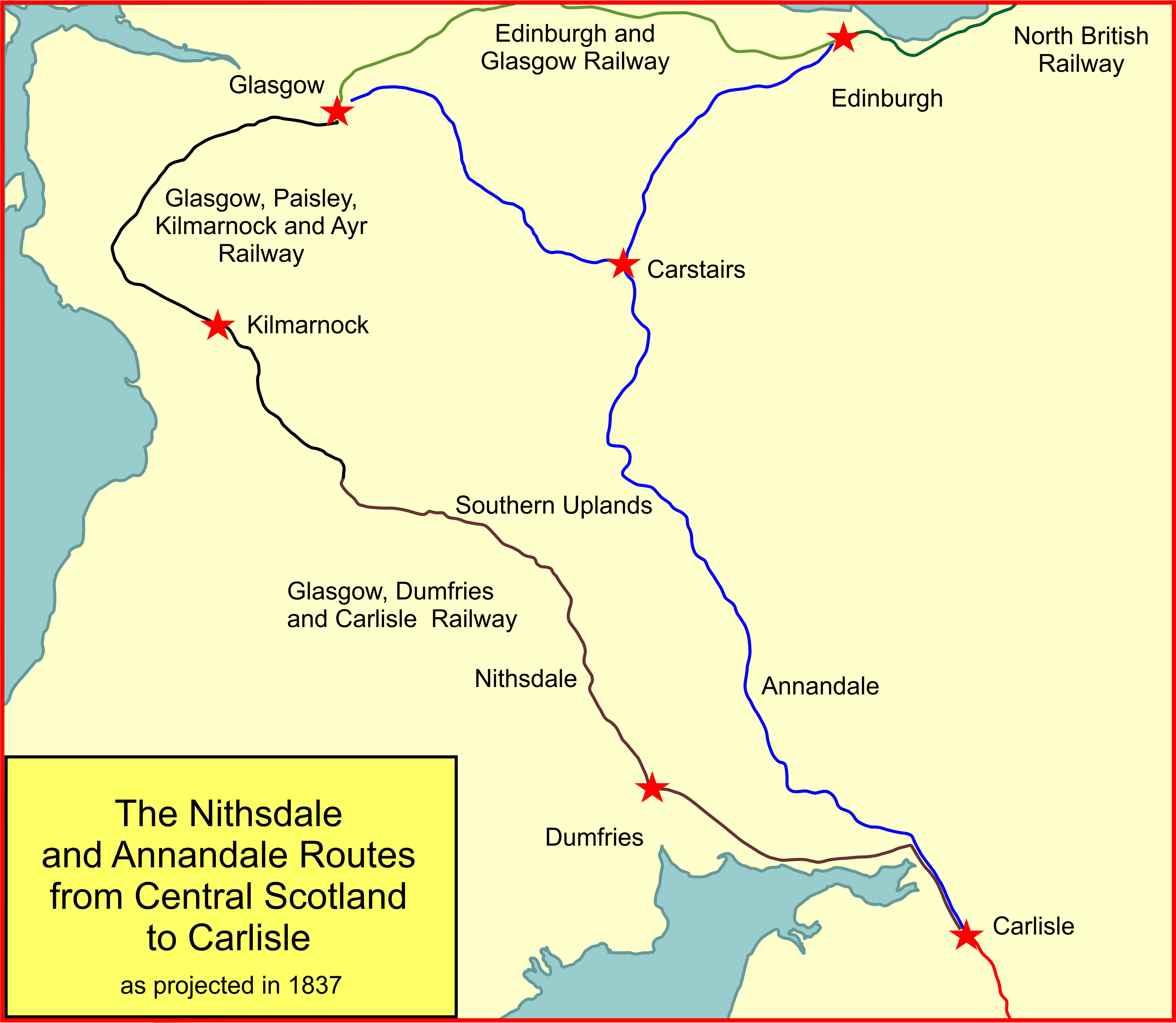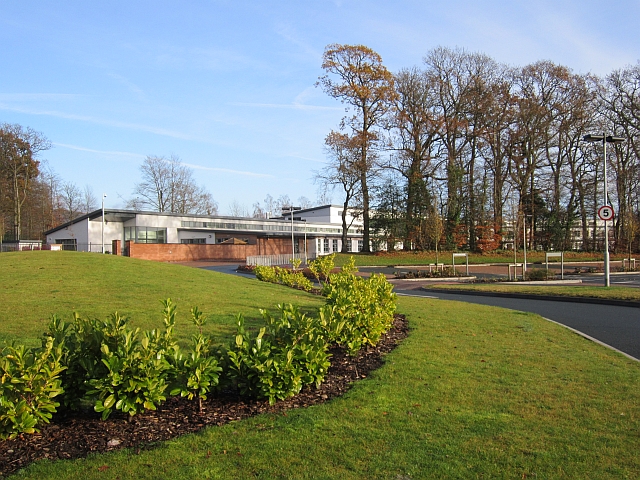|
Closeburn (Dumfries) Railway Station
Closeburn railway station was a railway station in Dumfries and Galloway Dumfries and Galloway ( sco, Dumfries an Gallowa; gd, Dùn Phrìs is Gall-Ghaidhealaibh) is one of 32 unitary council areas of Scotland and is located in the western Southern Uplands. It covers the counties of Scotland, historic counties of ... north of Dumfries, serving a rural community with Wallace Hall Academy and Closeburn Castle nearby. Its OS NGR is NX 8970 9234. History The station opened on 15 October 1849. The station is now closed, although the line running through the station is still open. The station buildings, goods sheds and station master's house still exist, but the platforms have been removed. Lost and found The 1897 - 1956 Found Items book from Closeburn has survived and is held in the Ewart Library in Dumfries. As per usual in Scotland items of waterproof clothing and umbrellas figure prominently in the list of recovered items.Rankin, Stuart (2006-7). Found Items Closeburn ... [...More Info...] [...Related Items...] OR: [Wikipedia] [Google] [Baidu] |
Dumfries And Galloway
Dumfries and Galloway ( sco, Dumfries an Gallowa; gd, Dùn Phrìs is Gall-Ghaidhealaibh) is one of 32 unitary council areas of Scotland and is located in the western Southern Uplands. It covers the counties of Scotland, historic counties of Dumfriesshire, Kirkcudbrightshire, and Wigtownshire, the latter two of which are collectively known as Galloway. The administrative centre and largest settlement is the town of Dumfries. The second largest town is Stranraer, on the North Channel (Great Britain and Ireland), North Channel coast, some to the west of Dumfries. Following the 1975 reorganisation of local government in Scotland, the three counties were joined to form a single regions and districts of Scotland, region of Dumfries and Galloway, with four districts within it. The districts were abolished in 1996, since when Dumfries and Galloway has been a unitary local authority. For lieutenancy areas of Scotland, lieutenancy purposes, the area is divided into three lieutenancy a ... [...More Info...] [...Related Items...] OR: [Wikipedia] [Google] [Baidu] |
Glasgow, Dumfries And Carlisle Railway
The Glasgow, Dumfries and Carlisle Railway was a railway company in Scotland, which constructed the line from near Cumnock to Gretna Junction, forming the route from Glasgow to Carlisle via Dumfries, in association with other lines. Its promoters hoped it would form the only railway between central Scotland and England, but it lost out to rival companies. It opened in stages between 1846 and 1850, and on completion of its line it merged with the Glasgow, Paisley, Kilmarnock and Ayr Railway. The combined company took the name Glasgow & South Western Railway (G&SWR). The G&SWR formed an alliance with the English Midland Railway and for many years express passenger trains ran between Glasgow and London over the routes. The line is open today, continuing to form part of the Glasgow - Kilmarnock - Dumfries - Carlisle line; but that has diminished in importance and is now a secondary route. Passenger services are operated by ScotRail. History A line into Ayrshire, and later to En ... [...More Info...] [...Related Items...] OR: [Wikipedia] [Google] [Baidu] |
Glasgow And South Western Railway
The Glasgow and South Western Railway (G&SWR) was a railway company in Scotland. It served a triangular area of south-west Scotland between Glasgow, Stranraer and Carlisle. It was formed on 28 October 1850 by the merger of two earlier railways, the Glasgow, Paisley, Kilmarnock and Ayr Railway and the Glasgow, Dumfries and Carlisle Railway. Already established in Ayrshire, it consolidated its position there and extended southwards, eventually reaching Stranraer. Its main business was mineral traffic, especially coal, and passengers, but its more southerly territory was very thinly populated and local traffic, passenger and goods, was limited, while operationally parts of its network were difficult. It later formed an alliance with the English Midland Railway and ran express passenger trains from Glasgow to London with that company, in competition with the Caledonian Railway and its English partner, the London and North Western Railway, who had an easier route. In 1923 the G&S ... [...More Info...] [...Related Items...] OR: [Wikipedia] [Google] [Baidu] |
London Midland And Scottish Railway
The London, Midland and Scottish Railway (LMSIt has been argued that the initials LMSR should be used to be consistent with LNER, GWR and SR. The London, Midland and Scottish Railway's corporate image used LMS, and this is what is generally used in historical circles. The LMS occasionally also used the initials LM&SR. For consistency, this article uses the initials LMS.) was a British railway company. It was formed on 1 January 1923 under the Railways Act of 1921, which required the grouping of over 120 separate railways into four. The companies merged into the LMS included the London and North Western Railway, Midland Railway, the Lancashire and Yorkshire Railway (which had previously merged with the London and North Western Railway on 1 January 1922), several Scottish railway companies (including the Caledonian Railway), and numerous other, smaller ventures. Besides being the world's largest transport organisation, the company was also the largest commercial enterpri ... [...More Info...] [...Related Items...] OR: [Wikipedia] [Google] [Baidu] |
Train Station
A train station, railway station, railroad station or depot is a railway facility where trains stop to load or unload passengers, freight or both. It generally consists of at least one platform, one track and a station building providing such ancillary services as ticket sales, waiting rooms and baggage/freight service. If a station is on a single-track line, it often has a passing loop to facilitate traffic movements. Places at which passengers only occasionally board or leave a train, sometimes consisting of a short platform and a waiting shed but sometimes indicated by no more than a sign, are variously referred to as "stops", "flag stops", " halts", or "provisional stopping places". The stations themselves may be at ground level, underground or elevated. Connections may be available to intersecting rail lines or other transport modes such as buses, trams or other rapid transit systems. Terminology In British English, traditional terminology favours ''railway station' ... [...More Info...] [...Related Items...] OR: [Wikipedia] [Google] [Baidu] |
Wallace Hall Academy
Wallace Hall is a 2-18, state-operated comprehensive school in Thornhill, Dumfries and Galloway, south-west Scotland. The school serves all school-aged children in the local area, with three distinct schooling types operating under one building. These are; The ELC (Early Learning Centre or Nursery), Primary School, and Academy. The ELC and Primary School serves children aged 2–12 located within Thornhill's local catchment area, whilst the Academy serves children aged 11–18 located within Thornhill's local catchment area, as well as a plethora of surrounding rural located Primary schools. As of March 2023, the school operates with a roll of 554 pupils (secondary), and 164 pupils (ELC and primary). History The original Wallace Hall was founded by John Wallace, a merchant in Glasgow and a native of Closeburn, who, in 1717, endowed £1400 for the purpose of erecting the school, on the basis for it to teach English, Latin, Greek, Writing, and Arithmetic, all for the children o ... [...More Info...] [...Related Items...] OR: [Wikipedia] [Google] [Baidu] |
Closeburn Castle
Closeburn Castle is a privately owned tower house, probably of the 14th century, but possibly older, and is one of the oldest continually inhabited houses in Scotland. The castle is located 1 km east of the village of Closeburn, in the historical county of Dumfriesshire, 2 km south-east of Thornhill, in Dumfries and Galloway, Scotland. History The Kirkpatrick family was confirmed in their lands of Closeburn in 1232 by Alexander II. The tower house was probably built in the late 14th century, although some sources give a date as early as 1180 or as late as 1420. Sir Roger de Kirkpatrick was with Robert the Bruce at Dumfries in 1306, and assisted in the murder of John "the Red" Comyn. His son, also Sir Roger, commanded a force which recaptured Caerlaverock and Dalswinton castles from the English in 1355. He was then murdered by Sir James Lindsay at Caerlaverock in 1357. In 1685 the Kirkpatricks' loyalty to Charles I was rewarded with a baronetcy. In the 17th century ... [...More Info...] [...Related Items...] OR: [Wikipedia] [Google] [Baidu] |
Thornhill (Dumfries) Railway Station
Thornhill is a closed station. It served the country town of Thornhill in Dumfries and Galloway. The station site is a mile or so from the town. Four miles north of Thornhill is Drumlanrig Castle, home to the Duke of Buccleuch and Queensberry. The Glasgow and South Western main line rail route between Kilmarnock and Dumfries is forced to make a long detour to the east of Thornhill and through a long tunnel, rather than the more logical route nearer Thornhill town centre and up the Nith Valley, so as not to be seen from the Buccleuch estate. The distance of the station from Thornhill may be one reason that passenger use was light and stopping services ended in 1965. There was formerly a busy livestock market near to the station, which eventually closed around 2001. Dumfries and Galloway Council are trying to find funding to reopen the station. Views at the station in 2009 The southbound loop has recently been opened to increase traffic paths on this line. The platforms, sig ... [...More Info...] [...Related Items...] OR: [Wikipedia] [Google] [Baidu] |
Closeburn Station Dumfries
Closeburn may refer to: * Closeburn, Queensland, a locality in the Moreton Bay Region, Australia * Closeburn, Dumfries and Galloway, in Scotland * Closeburn, Queenstown, in New Zealand {{Geodis ... [...More Info...] [...Related Items...] OR: [Wikipedia] [Google] [Baidu] |
Railway Stations In Great Britain Opened In 1849
Rail transport (also known as train transport) is a means of transport that transfers passengers and goods on wheeled vehicles running on rails, which are incorporated in tracks. In contrast to road transport, where the vehicles run on a prepared flat surface, rail vehicles (rolling stock) are directionally guided by the tracks on which they run. Tracks usually consist of steel rails, installed on sleepers (ties) set in ballast, on which the rolling stock, usually fitted with metal wheels, moves. Other variations are also possible, such as "slab track", in which the rails are fastened to a concrete foundation resting on a prepared subsurface. Rolling stock in a rail transport system generally encounters lower frictional resistance than rubber-tyred road vehicles, so passenger and freight cars (carriages and wagons) can be coupled into longer trains. The operation is carried out by a railway company, providing transport between train stations or freight customer facil ... [...More Info...] [...Related Items...] OR: [Wikipedia] [Google] [Baidu] |
Railway Stations In Great Britain Closed In 1961
Rail transport (also known as train transport) is a means of transport that transfers passengers and goods on wheeled vehicles running on rails, which are incorporated in tracks. In contrast to road transport, where the vehicles run on a prepared flat surface, rail vehicles (rolling stock) are directionally guided by the tracks on which they run. Tracks usually consist of steel rails, installed on sleepers (ties) set in ballast, on which the rolling stock, usually fitted with metal wheels, moves. Other variations are also possible, such as "slab track", in which the rails are fastened to a concrete foundation resting on a prepared subsurface. Rolling stock in a rail transport system generally encounters lower frictional resistance than rubber-tyred road vehicles, so passenger and freight cars (carriages and wagons) can be coupled into longer trains. The operation is carried out by a railway company, providing transport between train stations or freight customer faciliti ... [...More Info...] [...Related Items...] OR: [Wikipedia] [Google] [Baidu] |



.jpg)

